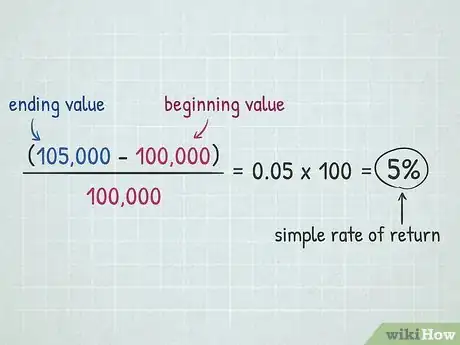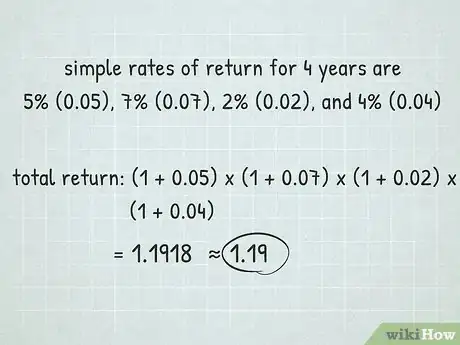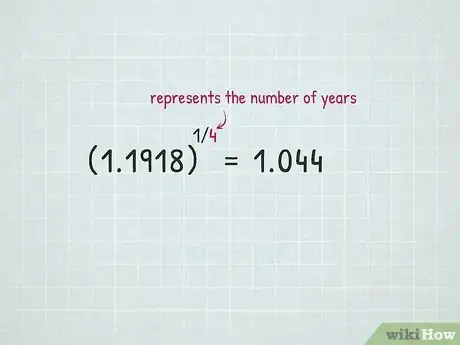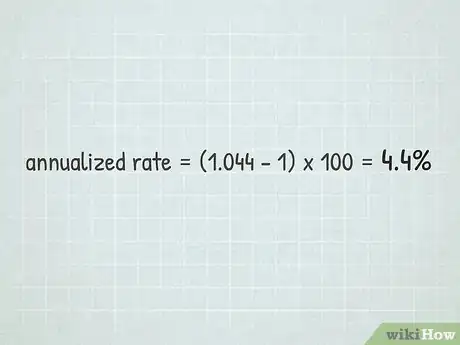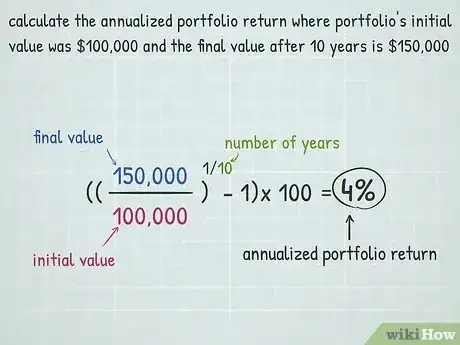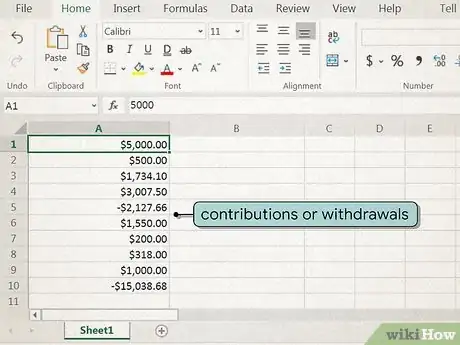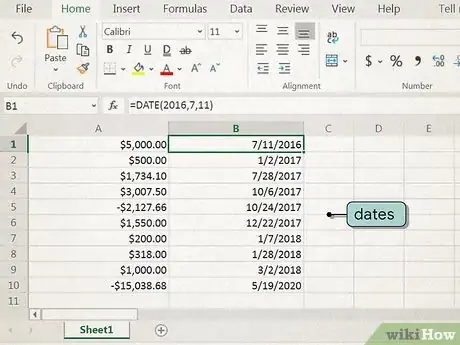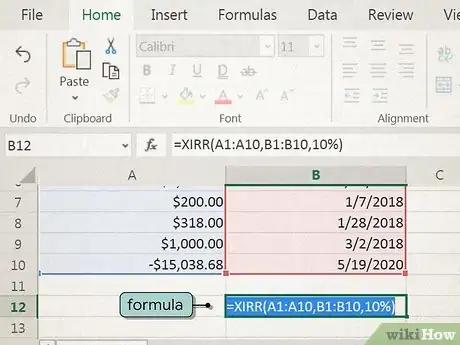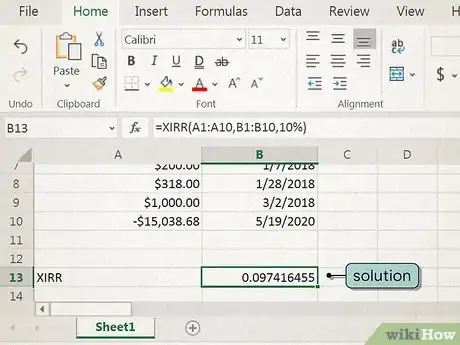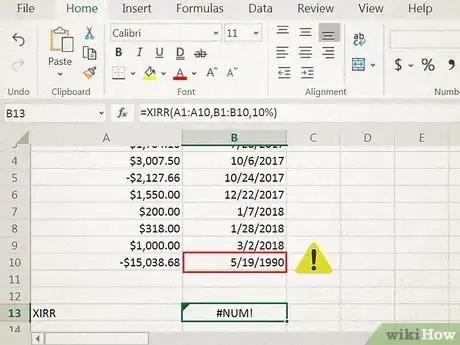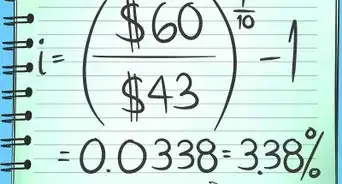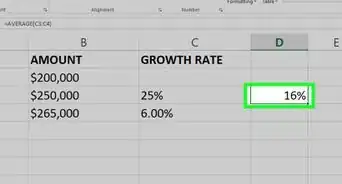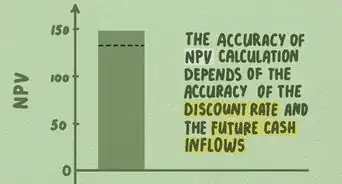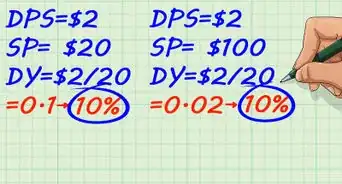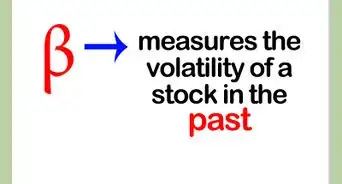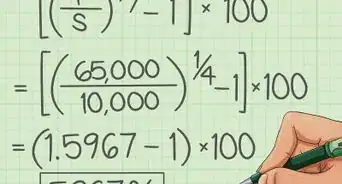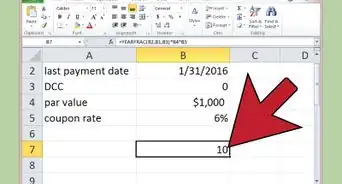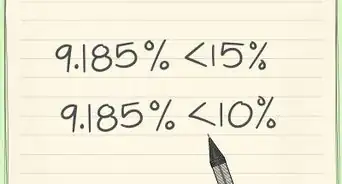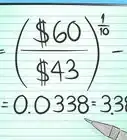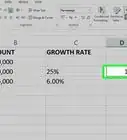This article was co-authored by Jonathan DeYoe, CPWA®, AIF® and by wikiHow staff writer, Jennifer Mueller, JD. Jonathan DeYoe is a Financial Advisor and the CEO of Mindful Money, a comprehensive financial planning and retirement income planning service based in Berkeley, California. With over 25 years of financial advising experience, Jonathan is a speaker and the best-selling author of "Mindful Money: Simple Practices for Reaching Your Financial Goals and Increasing Your Happiness Dividend." Jonathan holds a BA in Philosophy and Religious Studies from Montana State University-Bozeman. He studied Financial Analysis at the CFA Institute and earned his Certified Private Wealth Advisor (CPWA®) designation from The Investments & Wealth Institute. He also earned his Accredited Investment Fiduciary (AIF®) credential from Fi360. Jonathan has been featured in the New York Times, the Wall Street Journal, Money Tips, Mindful Magazine, and Business Insider among others.
There are 9 references cited in this article, which can be found at the bottom of the page.
This article has been viewed 539,032 times.
If you want to find out how much you're earning on your investments, you likely know that you can subtract the starting value from the ending value. If you then divide that number by the starting value and multiply by 100, you have the basic rate of return. But what if you've had your portfolio for several years? Your portfolio is (hopefully) growing every year, compounding your returns. If you want to compare your portfolio's performance with someone else's, the annualized portfolio return gives you the best way to do this. There are 2 different ways to calculate your annualized portfolio return. Your choice depends on whether you want to control for the effect that your contributions and withdrawals have on your portfolio's performance.[1]
Steps
Time-Weighted Rate of Return
This calculation shows you a rate of return that ignores investor behavior (deposits and withdrawals), making it the best way to compare the performance of investment managers and brokers.
-
1Find the difference between the beginning and ending values for each year. Subtract the value of the portfolio at the beginning of the year from the value of the portfolio at the end of the year, then divide that number by the value at the beginning of the year. This is your simple, or basic, rate of return. Multiply by 100 to find the percentage.[2]
- For example, if the beginning value of your portfolio was $100,000 and your ending value was $105,000, your simple rate of return for that year would be 5%:
- If you earned any dividends, include those in your ending value. In the previous example, if you'd also earned $50 in dividends, your ending value would be $105,050.
-
2Add 1 to each rate and multiply them together. Start by adding 1 to each basic rate of return you've calculated for each year. Then, multiply those figures together to calculate the return for the entire time frame. This incorporates the way the value of your portfolio builds on itself, or compounds over time.[3]
- For example, suppose you've had your portfolio for 4 years and your simple rates of return are 5% (0.05), 7% (0.07), 2% (0.02), and 4% (0.04). Your total return would be 1.19 (rounded):
Advertisement -
3Raise the total rate by an exponent of 1/n. In the exponent position, "n" represents the number of years you included in your calculations. You're trying to find the average for any 1 of those years, so the exponent is represented as a fraction of 1 over the number of years.[4]
- Continuing with the previous example, plug 1.1918 into your calculator and multiply by the exponent 1/4. Your answer should be 1.044.
- This calculation gets you a geometric average, which is simply an average of all the simple rates of return that also takes into account the compounding that occurs year after year.[5]
-
4Subtract 1 and multiply by 100 to get the annualized rate of return. Now that you have your geometric average, you need to turn it into a percentage. Subtract 1 (this takes care of the 1s you previously added to each yearly return) to get your decimal. Then, multiply 100 to get your percentage.[6]
- To continue with the example, your annualized rate would be 4.4%:
- The full formula is , where "R" is the rate of return for each investment period and "n" is the number of years.
-
5Use a different formula if you only have the initial and final values. To calculate the annualized portfolio return, divide the final value by the initial value, then raise that number by 1/n, where "n" is the number of years you held the investments. Then, subtract 1 and multiply by 100.[7]
- For example, suppose your portfolio's initial value was $100,000 and the final value after 10 years is $150,000. Divide 150,000 by 100,000 to get 1.5. Then apply to 1.5 the exponent 1/10 to get 1.04. Subtract 1 to get 0.04, then multiply by 100. Your annualized rate of return is 4%:
- The full formula is
Dollar-Weighted Rate of Return (IRR)
This calculation shows the impact your deposits and withdrawals have on your portfolio's performance and is best used to compare your portfolio's returns to another individual investor's returns.
-
1Enter your contributions or withdrawals in column A of a spreadsheet. Open a spreadsheet, then use column A to list each of your contributions or withdrawals to your portfolio, with your first value on row 1 (cell A1). Express withdrawals as negative numbers with a ( - ) in front of them.[8]
- Put each contribution or withdrawal in a new cell. There's no need to combine cash flows for specific periods. For example, if you made 2 contributions and 1 withdrawal in a single year, you'd have 3 entries in 3 cells rather than just 1.
-
2Put the dates of the contributions or withdrawals in column B. Next to the corresponding value in column A, type the date that contribution or withdrawal was made in column B. Use the "date" function so the program recognizes the values as dates.[9]
- In Excel, the date function is =DATE(Year,Month,Day). For example, if you made a contribution on January 15, 2020, you would enter "=DATE(2020,1,15)".
-
3Input the formula on a new row. Once you've entered all of your data, drop down a row and add the formula =XIRR(values,dates,[guess]). The 3 variables in the formula break down like this:[10]
- The values you enter refers to the range of cells containing the contributions or withdrawals you made. For example, if you used column A, rows 1 - 20, you would enter "A1:A20".
- For the dates, use the range of cells in the column containing your dates, using the same formula as you used for the values. For example, "B1:B20".
- The third value is your guess as to what you think the IRR will be. If you don't have a guess, you can leave this blank. Excel defaults to 10% if no guess is given.
-
4Allow the program to compute the solution in the same cell. Once you enter the formula in the cell, the program uses an iterative technique, which involves trying different rates in a complex equation until the correct one is found. These iterations start with your guess rate (or the default 10%) and move up or down to find the annualized dollar-weighted rate of return. The program will display the result in the same cell where you entered the formula.[11]
- The result Excel and other spreadsheet programs reach is accurate within 0.000001%, so it's a result you can rely on.
-
5Troubleshoot your data if you get an error. If you enter the formula and get an error message instead of a result, it usually means there's something wrong with the data you entered. If you get a "#VALUE" error, it means you have a date that isn't recognized as a valid date. A "#NUM!" error could result from any of the following:[12]
- Your value and date arrays are different lengths
- Your arrays don't contain at least 1 positive and at least 1 negative value
- One of your dates comes before the first date entered in your array
- The calculation failed to converge (find a result) after 100 iterations
Expert Q&A
Did you know you can get expert answers for this article?
Unlock expert answers by supporting wikiHow
-
QuestionHow do I calculate total return for on an investment that amortizes monthly in equal amounts over a one year time period?
 Michael R. LewisMichael R. Lewis is a retired corporate executive, entrepreneur, and investment advisor in Texas. He has over 40 years of experience in business and finance, including as a Vice President for Blue Cross Blue Shield of Texas. He has a BBA in Industrial Management from the University of Texas at Austin.
Michael R. LewisMichael R. Lewis is a retired corporate executive, entrepreneur, and investment advisor in Texas. He has over 40 years of experience in business and finance, including as a Vice President for Blue Cross Blue Shield of Texas. He has a BBA in Industrial Management from the University of Texas at Austin.
Business Advisor
-
QuestionHow do I annualize a return on an investment that has cash added or subtracted during the year?
 Michael R. LewisMichael R. Lewis is a retired corporate executive, entrepreneur, and investment advisor in Texas. He has over 40 years of experience in business and finance, including as a Vice President for Blue Cross Blue Shield of Texas. He has a BBA in Industrial Management from the University of Texas at Austin.
Michael R. LewisMichael R. Lewis is a retired corporate executive, entrepreneur, and investment advisor in Texas. He has over 40 years of experience in business and finance, including as a Vice President for Blue Cross Blue Shield of Texas. He has a BBA in Industrial Management from the University of Texas at Austin.
Business Advisor (1) Total the beginning Account Balance and any additions during the year to learn Total Investments. (2) Add any withdrawals during the year to the Ending Account Balance. (3) Subtract the sum of Step 1 from the sum of Step 2 to get total return. (4) Divide total return by the sum of Step 1 to get the rate of return within the year.
(1) Total the beginning Account Balance and any additions during the year to learn Total Investments. (2) Add any withdrawals during the year to the Ending Account Balance. (3) Subtract the sum of Step 1 from the sum of Step 2 to get total return. (4) Divide total return by the sum of Step 1 to get the rate of return within the year. -
QuestionWhat does an annualized portfolio tell you about your portfolio's performance?
 Jonathan DeYoe, CPWA®, AIF®Jonathan DeYoe is a Financial Advisor and the CEO of Mindful Money, a comprehensive financial planning and retirement income planning service based in Berkeley, California. With over 25 years of financial advising experience, Jonathan is a speaker and the best-selling author of "Mindful Money: Simple Practices for Reaching Your Financial Goals and Increasing Your Happiness Dividend." Jonathan holds a BA in Philosophy and Religious Studies from Montana State University-Bozeman. He studied Financial Analysis at the CFA Institute and earned his Certified Private Wealth Advisor (CPWA®) designation from The Investments & Wealth Institute. He also earned his Accredited Investment Fiduciary (AIF®) credential from Fi360. Jonathan has been featured in the New York Times, the Wall Street Journal, Money Tips, Mindful Magazine, and Business Insider among others.
Jonathan DeYoe, CPWA®, AIF®Jonathan DeYoe is a Financial Advisor and the CEO of Mindful Money, a comprehensive financial planning and retirement income planning service based in Berkeley, California. With over 25 years of financial advising experience, Jonathan is a speaker and the best-selling author of "Mindful Money: Simple Practices for Reaching Your Financial Goals and Increasing Your Happiness Dividend." Jonathan holds a BA in Philosophy and Religious Studies from Montana State University-Bozeman. He studied Financial Analysis at the CFA Institute and earned his Certified Private Wealth Advisor (CPWA®) designation from The Investments & Wealth Institute. He also earned his Accredited Investment Fiduciary (AIF®) credential from Fi360. Jonathan has been featured in the New York Times, the Wall Street Journal, Money Tips, Mindful Magazine, and Business Insider among others.
Author, Speaker, & CEO of Mindful Money Annualized portfolio return gives an investor a sense of how a portfolio has performed on an average annual basis over a period of time. It's a nice way to see how the portfolio has done, but it doesn't tell you anything about the portfolio's volatility or how it's done on a "risk-adjusted basis," so it isn't very useful by itself when you're comparing investments.
Annualized portfolio return gives an investor a sense of how a portfolio has performed on an average annual basis over a period of time. It's a nice way to see how the portfolio has done, but it doesn't tell you anything about the portfolio's volatility or how it's done on a "risk-adjusted basis," so it isn't very useful by itself when you're comparing investments.
Warnings
- Watch your order of operations on the calculations to make sure you get the correct answer. Double-check with a calculator if you're working by hand.⧼thumbs_response⧽
References
- ↑ https://www.investopedia.com/terms/m/money-weighted-return.asp
- ↑ https://youtu.be/sO6RNEShKYI?t=42
- ↑ https://www.kitces.com/blog/twr-dwr-irr-calculations-performance-reporting-software-methodology-gips-compliance/
- ↑ https://corporatefinanceinstitute.com/resources/knowledge/trading-investing/annual-return/
- ↑ https://www.investopedia.com/ask/answers/06/geometricmean.asp
- ↑ https://youtu.be/sO6RNEShKYI?t=80
- ↑ https://corporatefinanceinstitute.com/resources/knowledge/trading-investing/annual-return/
- ↑ https://www.whitecoatinvestor.com/how-to-calculate-your-return-the-excel-xirr-function/
- ↑ https://www.whitecoatinvestor.com/how-to-calculate-your-return-the-excel-xirr-function/
- ↑ https://corporatefinanceinstitute.com/resources/excel/functions/xirr-function/
- ↑ https://corporatefinanceinstitute.com/resources/excel/functions/xirr-function/
- ↑ https://corporatefinanceinstitute.com/resources/excel/functions/xirr-function/
- ↑ https://www.kitces.com/blog/twr-dwr-irr-calculations-performance-reporting-software-methodology-gips-compliance/
- ↑ Jonathan DeYoe, CPWA®, AIF®. Author, Speaker, & CEO of Mindful Money. Expert Interview. 15 October 2020.
About This Article
To calculate annualized portfolio return, start by subtracting your beginning portfolio value from your ending portfolio value. Then, divide the difference by the beginning value to get your overall return. Once you have your overall return, add 1 to that number. Next, divide 1 by the number of years you're measuring and write that number as an exponent next to your previous answer. Finally, raise your answer to the exponent and subtract 1 from that number to get your annualized return. To learn how to calculate annualized return with Excel, read on!
